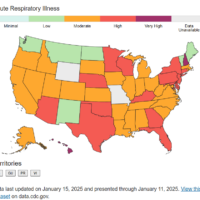As coronavirus continues its spread across Kentucky with nearly 29,000 cases, public health officials and Governor Andy Beshear have promoted contact tracing to mitigate it. But aside from targeted calls and follow-ups with those potentially exposed, some may not know how contact tracing works.
Public Information Officer Amanda Sweeney gave the run-down on the process she described as a “well-oiled machine” at Christian County Health Department.
Sweeney said CCHD both receives tests in the community and offers an off-site testing drive-thru service everyday from 9 to 11 a.m., weather permitting. She said tests are sent to a state laboratory to determine whether they are positive or negative. People with positive tests are referred to the department’s epidemiology team and are interviewed as soon as possible.

“‘Who have you been with within six feet for 10 to 15 minutes or more?’ And those individuals that have been in contact with that individual for six-feet-or-less, 10 to 15 minutes or more, are considered direct contacts,” Sweeney said.
She said CCHD gets in touch with those direct contacts and places them under quarantine, where they have to monitor their symptoms for 14 days. Sweeney said CCHD staff were originally contact tracing, but the state provided the department with funding to hire five additional contact tracers. She said the tracers receive hands-on training at CCHD and online from the state. The state’s COVID-19 website says contact tracers will not tell those potentially exposed who may have exposed them.
Sweeney said CCHD checks in with the direct contacts throughout the quarantine to see how they’re doing and whether they develop any symptoms. She said if they haven’t developed any symptoms by the end of those 14 days, they are released from quarantine. People who do develop symptoms are recommended for testing. She said if they test positive, their direct contacts are also examined.
Sweeney said the department recommends those who get tested because they think they have symptoms remain quarantined until they receive a negative test result.
“Just because, if you think you might have it we don’t want you in the community spreading it to others,” she said.
But Sweeney said there is an exception when a negative test result doesn’t always mean release from quarantine.
“If you’re a direct contact of an individual who’s tested positive… Let’s say you decide, ‘Well, let me just get tested to see if I have it.’ Even if you have a negative test result that doesn’t release you from quarantine because the virus can take two to 14 days to actually show up in the body or be detectable by a test. So, you may have contracted COVID-19, but maybe you don’t develop symptoms until day 14.”
Sweeney said Christian County’s proximity to Tennessee also makes contact tracing more complex. She said when positive cases cross state lines, CCHD has to work with the Tennessee Department of Health, which may have different strategies. She said CCHD has a good relationship with the Tennessee Department of Health, Montgomery County Health Department and Fort Campbell Public Health.
“It does get a little more complicated when you cross state lines, but we’re fortunate to have good partners that work together within this area,” Sweeney said.
More information on contact tracing here.





